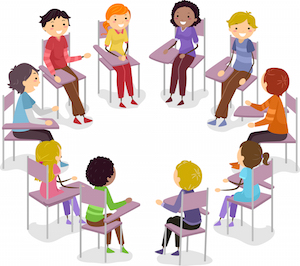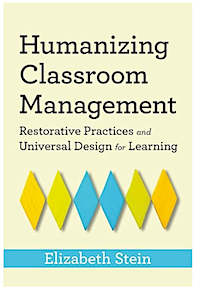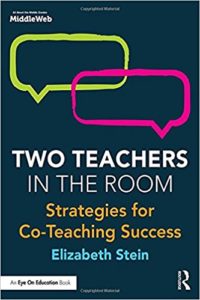Using Proactive Solutions with ‘Disruptive’ Students
By Elizabeth L. Stein
Sam is a fifth grader who is a frequent flyer to the principal’s office for behaviors deemed by his co-teachers as “disruptive, impulsive, and borderline disrespectful.”
Sam is known to push books off of his desk and throw pencils across the room whenever it’s time to transition to a new subject area. In addition, during class discussions, he loudly shares comments such as “This is stupid! Why do we need to know this anyway!” Teacher attempts to redirect Sam just further ignite his behaviors.
Hence, his frequent flyer status—and his label as the Disruptive Student.
Fast forward…
Let’s place Sam in a middle school setting. If his behaviors are not understood and redirected in ways that work for everyone, he will be that student who lives up to his elementary school label. He will be that student whose behaviors may increase to levels that land him in the “In-School Suspension” room as a way to try to “teach” him how he should behave in school.
So what can we do about Sam?
I recently read this New York Times opinion piece, The “Problem Child” Is a Child, Not a Problem, and I thought about students like Sam. Dr. Ross Greene’s work, now called Collaborative and Proactive Solutions (CPS), is a research-based approach to get to the bottom of understanding the function of students’ behaviors and – more importantly – to proactively problem solve issues through relationships with the student as a part of the process of activating proactive solutions.
It is an amazingly effective approach that I applied with great success during a resiliency summer school program I coordinated in my district.
Dr. Greene’s work connects with the vision and value of applying restorative justice practices within classroom management plans. But it’s not just about the vision and value – it’s about the necessity to replace traditional and punitive models such as in-school suspension, time out, or trips to the principal as a way to force students to reflect on their behaviors.
Students frequently respond to these traditional methods as a detached, “shame on you!” kind of “let me just pass the time away” experience that rarely connects the students’ behaviors with proactive solutions.
Time to shift to Restorative Justice!
The term Restorative Justice can easily conjure up a sense of peace, respect, and acceptance in the minds of in-the-know educators. It’s about keeping a focus on educating the whole child – knowing that we will work with students who need to learn more than content-area material. Effective educators must guide students to learn about themselves as learners, which includes their personal behaviors, attitudes, and decisions that they can control.
Traditional ways of dealing with behaviors involve the educator controlling the child. Restorative justice practices recognize the value of the student’s perspective and his or her personal power and ability to make better decisions in the process of being part of a learning community.
Becoming Restorative Justice educators
In my book Two Teachers in the Room: Strategies for Co-Teaching Success, I share my passion for engaging students proactively in reaching better decisions – helping them come to understand how their actions can positively affect their learning and the learning of others in their classes.
It’s all about viewing student behavior through the lens of a learning community. It’s about restoring and building relationships, so everyone knows they are valued members of the group.
Here are some quick strategies from Two Teachers in the Room that can embrace all learners’ needs while redirecting students like Sam toward becoming proactive, considerate members of your classroom learning community.
Check-In: Make time for students to share how they are doing in the class’s opening moments. This two-to-three minute class share goes a long way toward cultivating relationships and guiding each student to feel valued.
Acceptance Circle: Let’s face it…there will always be times when a student may share a negative (and potentially shocking) response that disrupts the sense of calm in the room. Implementing an acceptance circle approach of five or so minutes can nip a potentially disruptive outburst.

“Is it OK to feel like something is stupid? When you feel this way, what decisions can you make so your feelings do not interfere with the learning for others? Can we all agree to learn with someone who feels this way?”
The point is that the teacher sends the message to Sam and the other students that our feelings are fine, so long as we consider how the expression of our feelings affects others.
In Sam’s case, the above example illustrates to him and to his classmates that he is not alone. There are times when others in the room feel that way as well. The conversation would quickly flow with other students sharing how they act when they feel that way—and they also share how they feel when their own learning is disrupted by others.
In this scenario Sam feels valued and supported within this community and can make better choices about acting upon his feelings. It’s a powerful process that may take time and teacher resilience to meet with success. Taking five minutes out of class to do this keeps the focus on the importance of the content-area material—but it makes time to value every learner as a valued member of that community.

You can even set up an actual spot in the classroom where students can go to if they just need to personally regroup. Set up this spot with the option for students to just close their eyes, take deep breaths – even use colored pencils to journal or sketch – as a positive release and redirection, so they may rejoin the group.
Bring students to learning, including those “Sams” in your classroom
Restorative justice practices put students like Sam in control of their behaviors. They are not forced to be separated from their peers in punitive ways. Instead, these strategies guide them to feel accepted, supported, and capable of taking charge of themselves and making positive, proactive decisions.
For more resources and ideas check out this collection of Restorative Practices resources at Edutopia. link to on Restorative Justice: Resources for Schools.
And if you have some time, listen to this discussion between Dr. Greene and two UK educators at the Yellow Ladybugs vlog.
As always, I would love to hear your thoughts! Share your connections, questions, and overall ideas here! Leave a comment to further these necessary conversations—and ultimate action steps! What’s happening in your classrooms and schools?



































I use a lot of these techniques in my classroom, but I also feel very strongly that students who do well in traditional school learning environments have less valuable academic experiences because of the time spent on the one or two kids who are never sent out when models like this one are used exclusively.
Anyone who teaches middle school students knows that they are different from week to week: gains made one week might be lost the next when a different part of puberty hits or when the switch friend groups. The students most interested in doing the work of school often miss many valuable minutes of class time if teachers do not have a place to send a student who is unwilling or unable to allow other students to work productively.
Lastly, administrators should be wary of implementing school-wide policies like this one. If teachers don’t believe in it, it will feel hokey and fake to the students. That three minute check in is really valuable for me and my students. How valuable would it be if they had it in every class every day? I think they’d feel like that wasn’t genuine. Has research been done on that?
This is great in theory. Most teachers who have honed in on class management already do some of these strategies. I was a teacher for many years and am shocked and saddened to see the disrupted learning in the classroom grow exponentially. Physical outbursts and volatile behavior impacts the emotional well being of every child in the classroom. Why would we repeatedly expose young learners to this traumatic environment? Instead of learning to write they are learning to survive. The classroom is not peaceful. What rights to the rest of the class have???? The children that have these aggressive, volatile impulse responses have an entire team working with them. I have watched behavior among other classmates escalate as a side effect. And, in my child’s classroom restorative justice strategies just mean a community circle and switching language like “That is unacceptable” to “So and so is having BIG behavior so do what’s expected”–so we no longer teach that behavior is wrong. We no longer allow kids to express fear about being victimized…we just quickly force them on to the next thing while they are internalizing their fears and worries. No wonder why we’ve have 5-6 1st graders refusing to go to school throughout the year!! Incredibly sad.